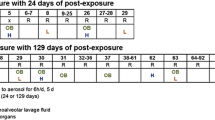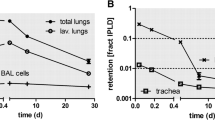Abstract
Wistar male rats were exposed to nickel oxide (NiO) aerosols (mass median aerodynamic diameter, 1.2 and 4.0 μm). The average exposure concentration was controlled from a low level of 0.6 mg/m3 to a high level of 70 mg/m3 and total exposure time was 140 h. Some rats were sacrificed just after the exposure, whereas others were exposed for 1 mo and kept for 12 and 20 mo clearance periods before sacrifice.
There were no differences in body weight gain between NiO exposure groups and controls.
Nickel concentrations in lungs of exposure groups were much higher than those of controls and decreased with the passing of the clearance time. No apparent deposition of nickel was observed in the liver, kidney, spleen, and blood immediately after the exposure, but in the case of the high exposure groups, the nickel concentration in the liver, spleen, and blood slightly increased with the increasing time of clearance.
The biological half time of NiO deposited in the lungs was estimated by the assumption that the amount of the clearance is proportional to the amount of the NiO deposited. This resulted in a biological half time of 11.5 and 21 mo for 1.2 and 4.0 μm, respectively.
Similar content being viewed by others
References
ACGIH, in threshold limit values for chemical substances and physical agents in the workroom environment with intended changes for 1983, Publications Office ACGIH, Cincinnati, Ohio, 1983, p. 27.
NIOSH, in HEN publication No. 77-164 US Gov. Printing Office, Washington, DC, 1977, p. 23.
R. Saracci, inQuantification of Occupational Cancer, Banbury Report 9, Cold Spring Harbor Laboratory, Cold Spring Harbor, 1981, p. 165.
Y. Kodama, S. Ishimatsu, K. Matsuno, I. Tanaka, and K. Tsuchiya,Biol. Trace Element Res. 7, 1 (1985).
I. Tanaka, H. Hayashi, A. Horie, Y. Kodama, T. Akiyama, and K. Tsuchiya,J. UOEH 4, 441 (1982).
I. Tanaka and T. Akiyama,Ann. Occup. Hyg. 28, 157 (1984).
I. Tanaka, K. Matsuno, Y. Kodama, and T. Akiyama,J. UOEH 5, 423 (1983).
A. Illis, G. C. Nowlan, and H. J. Koehler,CIM Trans. 123, 44 (1970).
Author information
Authors and Affiliations
Rights and permissions
About this article
Cite this article
Tanaka, I., Ishimatsu, S., Matsuno, K. et al. Biological half time of deposited nickel oxide aerosol in rat lung by inhalation. Biol Trace Elem Res 8, 203–210 (1985). https://doi.org/10.1007/BF02917459
Received:
Accepted:
Issue Date:
DOI: https://doi.org/10.1007/BF02917459
Index Entries
- Biological half time, of nickel oxide
- inhalation toxicity, of NiO
- health effect, of NiO
- respirable dust, of NiO
- nickel oxide, biological half time of an aerosol
- aerosol, toxicity of an inhaled NiO
- rat lung, biological half time of an inhaled NiO aerosol in
- lung, biological half time of an inhaled NiO aerosol in rat




